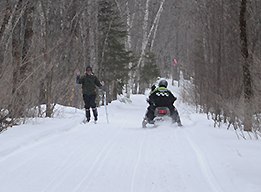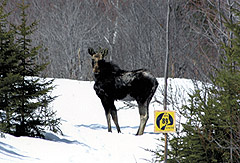 |
Ride Right in Maine TO RIDE RIGHT IN MAINE means to follow a few guidelines that can help to make snowmobiling safe for everyone on the trails:
TO RIDE RIGHT IN MAINE means to follow a few guidelines that can help to make snowmobiling safe for everyone on the trails:Ride to the right. Ride sober. Ride at a reasonable speed. Stay on the marked trails. Use hand signals. Ride defensively. Common sense. Of course, there are many more safety guidelines that can contribute to your good times on the trails - but these six rules make a good beginning. The MSA encourages all snowmobilers to take a snowmobile safety course. The Maine Dept. of Inland Fisheries and Wildlife (IF&W) offers certified courses; check out IF&W's listing of scheduled safety courses. You'll find more information about snowmobile safety in the MSA's Ride Right - Ride Smart course booklet. If you encounter another user on the trails, slow down and pass with caution and courtesy. RIDE TO THE RIGHT - It is required by law that a snowmobiler operate to the right of center on the trail when approaching or navigating a curve, corner, grade or hill - stay to the right, even on straightaways. RIDE SOBER - Don't drink and ride. Don't let anyone in your group drink and ride. Maine has a tough snowmobile OUI law. Restaurants, Inns, Lodges and Resorts welcome snowmobilers who want to have a few drinks with their friends. But please do it after you've finished sledding, not while riding. RIDE AT A REASONABLE SPEED: Speed on a Maine snowmobile trail is measured on a standard of reasonable speed for the existing conditions. If you cannot control your sled safely at the speed that you are traveling in the current conditions - you're speeding. Slow down. Snowmobile clubs across the state host radar runs, hill climbs and races. If you want to ride hard and fast, try one of these events, and take home a trophy to boot! USE HAND SIGNALS: The consistent use of a simple set of standardized hand signals on the trails keeps movement orderly and predictable. These standardized signals inform other sledders of your actions and allow everyone around you to anticipate the need to slow down. The MSA has distributed thousands of copies of these hand signals over the past decade and reports from the trails are that signal usage is up significantly. Good job, folks. This simple skill is one that every snowmobiler can learn and use to increase their safety on the trails. RIDE DEFENSIVELY: You and your group can do everything right, and still encounter a sledder who's doing everything wrong. Don't let their poor judgment or illegal behavior injure you. Always expect the unexpected from the sledder coming toward you. If there is a problem, you'll be prepared to respond and avoid a dangerous situation.  ...And keep an eye out for wild animals as well. Moose and deer live where you're sledding. Wildlife always have the right of way. ...And keep an eye out for wild animals as well. Moose and deer live where you're sledding. Wildlife always have the right of way. If you come up behind a moose on the trail keep your distance and wait for the animal to lumber off. If the moose shows an interest in the fact that you are on the trail, back off even further or leave. Please don't turn off your sled and follow animals on foot to get a better look. You may get a much closer look than you want. Photo by Alan Swett. Moose along ITS 89. Carry a map and stay on the marked trails. The snowmobile clubs work with landowners to determine the best location for the trails, considering landowner preference, rider safety and the protection of resources. Don't snowmobile alone. If you run into mechanical trouble, you'll have someone along who can truck you back home; bury your sled, and there's extra hands to help dig out; take a wrong turn, and there's someone else to blame... Take care crossing public ways - on busier roads, have a member of the group check for traffic and direct sledders across. Let someone know where you're planning to go and when you plan to return. An itinerary form left with a friend, the motel staff etc is invaluable if you actually run into trouble on the trail. If your return is delayed, contact the person aware of your trip plans if at all possible, to head off an unnecessary search effort. Print out a few itinerary forms and have them available for your next trip... and check weather reports before heading out. Ever been on a sled in a white out? Enough said. Dress appropriately (layers) and wear a helmet. No one should operate a snowmobile without the protection of a helmet. A life saver in the case of an accident, your helmet will also keep you protected from the occasional tree branch "face slapper" and inclement weather. Carry a basic repair kit. Saves a lot of frustration if you have a spare belt, a couple tools, etc. with you. An even better idea is to give your sled a good going over before every trip. Don't cross frozen bodies of water unless you are absolutely sure of ice thickness. Trails generally will not lead you across ponds or lakes. Bridges are provided to cross rivers and streams. However, you will encounter some places where you may cross water, such as marked passage on well frozen lakes - check locally for current ice thicknesses. Don't overdrive your lights. Don't tangle with a wire, stump or rock on a fast machine in the middle of a cold, dark night. Remembering these safety guidelines will help you to Ride Right in Maine and enjoy snowmobiling the way it should be - fun and safe. Interactive Snowmobile Safety CD  Since the MSA and IF&W introduced the Ride Right, Ride Smart interactive snowmobile safety CD several years ago, thousands of snowmobilers have used this fun and innovative product to increase their safety knowledge. The program is designed for use on your personal computer, allowing you, your friends and family to take the course in your own home! Copies of the CD have been supplied to every middle and high school library in the state of Maine for the use of snowmobiling young people state-wide.
Since the MSA and IF&W introduced the Ride Right, Ride Smart interactive snowmobile safety CD several years ago, thousands of snowmobilers have used this fun and innovative product to increase their safety knowledge. The program is designed for use on your personal computer, allowing you, your friends and family to take the course in your own home! Copies of the CD have been supplied to every middle and high school library in the state of Maine for the use of snowmobiling young people state-wide. The course leads the rider on a virtual snowmobile trip across Maine. Using video and displayed text, the student learns the basics of snowmobile safety along the way. At various times on the trip, the rider must refuel their sled by taking a short quiz. Upon completion of the course, the rider can print out the tests and a completion certificate. The CD is available free of charge at the MSA office, 7 Noyes Street Place in Augusta and the IF&W Info Center on State St. in Augusta. If you wish to have a copy of the CD mailed to you (U.S./Canada only, please), we ask that you include $5 to cover postage and packaging. Send your request, mailing address and $5 per CD to: Safety CD, MSA, PO Box 80, Augusta ME 04332. (Fees waived for educators, librarians, youth/scout leaders, corporate safety committees, etc. - contact the MSA with your requests.) The Ride Right, Ride Smart Safety CD was funded by the Maine Outdoor Heritage Fund, IF&W Dedicated Snowmobile Enforcement Fund and the MSA's Brian Wass Safety Education Fund. |